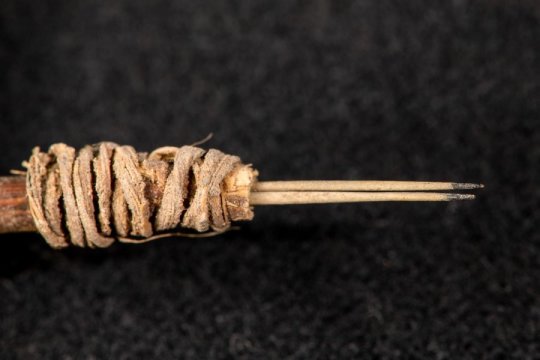[ad_1]
Washington State University archaeologists have discovered the oldest tattooing artifact in western North America.
With a handle of skunkbush and a cactus-spine business end, the tool was made around 2,000 years ago by the Ancestral Pueblo people of the Basketmaker II period in what is now southeastern Utah.
Andrew Gillreath-Brown, an anthropology PhD candidate, chanced upon the pen-sized instrument while taking an inventory of archaeological materials that had been sitting in storage for more than 40 years.
He is the lead author of a paper on the tattoo tool which was published today in the Journal of Archaeological Science: Reports.
His discovery pushes back the earliest evidence of tattooing in western North America by more than a millennium and gives scientists a rare glimpse into the lives of a prehistoric people whose customs and culture have largely been forgotten.
“Tattooing by prehistoric people in the Southwest is not talked about much because there has not ever been any direct evidence to substantiate it,” Gillreath-Brown, 33, said. “This tattoo tool provides us information about past Southwestern culture we did not know before.”
Tattooing is an artform and mode of expression common to many indigenous cultures worldwide. However, little is known about when or why the practice began.
This is especially the case in places like the southwestern United States, where no tattoos have been identified on preserved human remains and there are no ancient written accounts of the practice.
Instead, archaeologists have relied on visual depictions in ancient artwork and the identification of tattoo implements to trace the origins of tattooing in the region.
Previously, bundled and hafted, or handled, cactus spine tattoo tools from Arizona and New Mexico provided the best archaeological examples of early tattoo implements from the Southwest. The earliest of these have been dated to between AD 1100-1280.
So when Gillreath-Brown came across a very similar looking implement from a site in Utah that is 1,000 years older, he knew he had found something special.
“When I first pulled it out of the museum box and realized what it might have been I got really excited,” said Gillreath-Brown, who himself wears a large sleeve tattoo of a turtle shell rattle, mastodon, water, and forest on his left arm.
The tool consists of a 3 ½ inch wooden skunkbush sumac handle bound at the end with split yucca leaves and holding two parallel cactus spines, stained black at their tips.
“The residue staining from tattoo pigments on the tip was what immediately piqued my interest as being possibly a tattoo tool,” Gillreath-Brown said.
Encouraged by Aaron Deter-Wolf, a friend and co-author of the study who had done ancient tattooing and edited several books on the subject, Gillreath-Brown analyzed the tips with a scanning electron microscope, X-ray florescence and energy dispersive ray spectroscopy. For good measure, he did several test tattoos using a replica on pig skin.
He saw the crystalline structure of pigment and determined it likely contained carbon, a common element in body painting and tattooing.
The find, said Gillreath-Brown, “has a great significance for understanding how people managed relationships and how status may have been marked on people in the past during a time when population densities were increasing in the Southwest.”
[ad_2]















